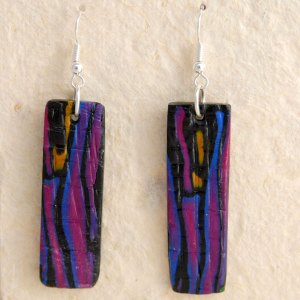[:en]When it comes to polymer clay I’m still very much a beginner. I’ve made a few things I like but haven’t developed enough of a technique to be able to make really perfect pieces. Not that perfection is always important. As with everything handmade, sometimes leaving your mark is actually a plus and, like everything else, the more you work the better you get.
I’ve picked up polymer clay again now because I wanted to do a specific pendant with color gradients. When I picked up the clay I noticed it had gotten really hard and flaky – it had been at least a year since I last used it for anything so that was no surprise. It was just a bit frustrating because instead of making my pendant I spent days reconditioning clay before I could get anything else done.
To recondition the clay I tried using baby oil, sewing machine oil and even a glycerin lubricant. Each seemed to work fine and none of the initial experiments seemed to have a negative effect on the curing process or the end result. I decided to stick with baby oil because it seemed the most harmless.
This was my reconditioning technique: I hammered the dry clay with a plastic hammer until it was reasonably flat and then rolled it on the pasta machine. It came out in flaky bits at the bottom so I added some baby oil and mushed it all into a ball. I let it sit for a bit (while rolling another color in the pasta machine, for example) and then come back to it, hammer it again and roll it again. After rolling it in the pasta machine about 10 times the clay started to get to the right consistency one more. Once or twice I added too much oil and it got really sticky so I let it sit for a few hours or overnight and it was fine again.
So after a day or two of this I finally got the pendant done and decided I should stick with the clay for a while longer, learn a few things and use up the leftover clay so it won’t get crumbly again.
I started by making a necklace from a tutorial by clay artist Christi Friesen. I had the tutorial for ages because I love the organic look of those leaves, even though it’s not a look I would have ever come up with on my own (I naturally tend towards more geometrical and abstract patterns) but I never got around to trying it out. I like the way the necklace turned out and I think I managed the general feel of the thing but some of the tendrils got a bit more squished than I would have liked and I’m sure it will turn out better if I make it again. I didn’t have mica powder to brush over the leaves so I used a loose powder eye shadow that worked just as well.
The matching earrings I made later turned out a little better.
At this point I wanted to explore color palettes so I picked up the last book I bought on the subject called Polymer clay color inspirations. It’s a really good book to help you brush up on color theory. I studied that in college and I’ve always been rather intuitive when it comes to color but it’s always helpful to refine some concepts once in a while. Also, I’ve used color in webdesign for many years but that is totally different from mixing clay in order to come up with a specific tone. It’s harder to fix mistakes, for one. The theory is the same but to instinctively know how much magenta or yellow to add is a trial and error process.
I wanted to make an Art Nouveau pendant and a flower cane seemed like a fun way to do it. Unfortunately I didn’t like the end result so I scrapped the cane. While I was cutting up the clay I decided to roll some of it that had an interesting color scheme through the pasta machine and ended up making a pendant and some earrings out of it.
I like the earrings because they look like a painting. I textured the surface to add a little extra interest.
After this failed attempt I decided to stick to color schemes that can’t go wrong and went with warm colors and a different technique.
I made a bunch of sheets in tones of yellow, orange, red and burgundy, cut circles out of each, stacked them up, extruded the resulting log that I then cut into nine parts, arranged them into a cube and cut that into slices. From these square slices I made a brooch and some earrings that remind me of Kandinski’s farbstudie quadrate painting (only not so colourful).
You can still tell where the seam is because I didn’t want to mess with the surface of the pendant too much. Apart from that I think it works.
Next I think I’m going to tackle surface textures. I just need the picture of the finished product to pop up in my head first because even when I’m working on book or tutorial projects I never like to do something that’s exactly like the example given. What’s the point in that? I believe you should always put a bit of yourself in everything you do even if it’s based on someone else’s work.[:]





